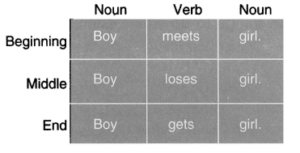Our Story starts in an exceedingly straightforward manner. We shall employ a mere nine words to encapsulate the entire narrative. This nine-cell layout constitutes the fundamental structure in the English language.
Each sentence encompasses three components - noun, verb, noun. Each tale consists of three segments - introduction, body, conclusion. Subsequently, you will acquaint yourself with diverse configurations, yet by mastering this format, you will consistently possess the capacity to convey your thoughts lucidly, whether through speech or in written form. One of the paramount actions to undertake while absorbing a narrative is to pose queries. Commit these structures to memory:
What does ____ mean?
What is a _____ ?
I don't know what a _______ is.
I don't know what that means.
How do you say _____ in English?
Excuse me, could you say that again, please?
Telling a Story - Introduction
Please listen to the audio and repeat the basic nine-word story out loud five times.

Moving forward, we will engage in exercises that involve this uncomplicated narrative using eight distinct approaches: vocabulary, grammar, word order, story sequence, phrasing, intonation, word connections, and pronunciation.
Asking questions is pivotal for assimilating new vocabulary. What is the definition of "meet"? What is the meaning of "boy"?
Telling a Story - Grammar
Commit the parts of speech to memory.
"Boy" and "girl" function as nouns, while "meets," "loses," and "gets" are verbs.
Telling a Story - Word Order
Please listen to the audio and vocally repeat the story five times, with a focus on the arrangement of words.
The arrangement of words begins with the boy as the subject, concludes with the girl as the object, and is connected by the verbs (meets, loses, gets).

Telling a Story - Story Order
Listen to the recording and verbally repeat the narrative five times, concentrating on the arrangement of words.
The sequence of the story begins with the encounter, shifts in the middle with the setback, and concludes with the joyful couple.

When constructing a noun-verb-noun sentence, the nouns carry more weight than the other terms, placing greater emphasis on "boy" and "girl." In the subsequent sentence, since you are already acquainted with the boy and girl, you must highlight the contrast by emphasizing the verb. Employ staircase intonation for this purpose.
Intonation
Listen to the recording and vocalize it five times, paying careful attention to accurate intonation.

Take note of the arrows situated to the right of the box in the upcoming exercise. These arrows serve as indicators for the tonal variations in your voice, allowing you to recognize that the initial two sentences do not signify the conclusion of the story.
Phrasing
Pay close attention to the audio and verbally repeat the content five times. Observe the arrows that indicate the phrasing

Pronunciation Intro
Lend your ear to the audio and vocally reproduce the sounds aloud five times. These specific five sounds will be employed whenever you engage in speech.

Pronunciation
Listen to the audio and vocalize it audibly five times. Concentrate on achieving accurate pronunciation.

There are three pronunciation focuses: "meets," "loses," and "girl." Pronounce a distinct "ee" sound in "meets," avoiding any similarity to "mitts." The two "S's" in "loses" should sound like "Z." The "R" sound should be distinct and pronounced from the throat.
Please note: In this book, you will come across three symbols used interchangeably - , " and ' - representing a soft vowel sound that can be slightly skipped over, as in "possble," "poss'ble," or "possable."